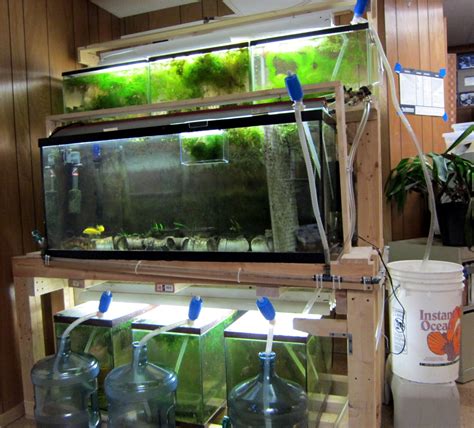Aquarium water change and maintenance are crucial aspects of fishkeeping, and the frequency and intensity of these tasks vary depending on the size, bioload, and species of fish in the aquarium.

Why Aquarium Water Change and Maintenance Matters
- Water Quality: Regular water changes and maintenance practices help remove toxic waste products, such as ammonia, nitrite, and nitrate, which can accumulate over time and harm fish.
- Fish Health: Clean, well-maintained water provides an optimal environment for fish to thrive and exhibit healthy behaviors.
- Algae Control: Water changes help dilute algae-promoting nutrients, such as phosphates and nitrates, reducing algae growth.
- Equipment Functionality: Routine maintenance tasks, such as cleaning filters and heaters, ensure that aquarium equipment operates effectively and efficiently.
- Long-Term Health: A consistent water change and maintenance schedule helps maintain a stable and healthy ecosystem, reducing the risk of disease outbreaks and other problems.
Water Change Frequency
The frequency of water changes depends on various factors, including:
- Tank Size: Smaller tanks require more frequent water changes than larger tanks.
- Bioload: The number of fish and other aquatic organisms in the tank affects the amount of waste produced, requiring more frequent water changes.
- Filter Efficiency: A powerful filter can help reduce the amount of waste that accumulates in the water, allowing for less frequent water changes.
- Stocking Level: Overcrowded tanks require more frequent water changes than tanks with fewer fish.
General Guidelines for Water Changes
- Small Tanks (Under 20 Gallons): 20-25% water changes weekly.
- Medium Tanks (20-50 Gallons): 25-30% water changes every two weeks.
- Large Tanks (Over 50 Gallons): 30-50% water changes every three weeks or monthly.
Water Maintenance
In addition to water changes, regular maintenance tasks are essential for a healthy aquarium. These tasks include:
- Gravel Cleaning: Use a gravel vacuum to remove debris and waste from the gravel substrate.
- Filter Cleaning: Regularly rinse or replace filter media to remove trapped waste and maintain filtration efficiency.
- Heater Inspection: Check the heater and ensure it operates correctly and at the desired temperature.
- Water Testing: Use test kits to monitor water parameters, such as pH, ammonia, nitrite, and nitrate, and adjust accordingly.
Benefits of a Regular Maintenance Schedule
- Reduced Water Quality Fluctuations: Regular water changes and maintenance help stabilize water parameters, reducing stress on fish.
- Improved Fish Health: Clean water and a healthy ecosystem promote fish well-being and reduce the risk of disease.
- Reduced Algae Growth: Less frequent water changes can lead to algae accumulation, which can compete with plants for nutrients and block light.
- Lower Maintenance Costs: A regular maintenance schedule reduces the likelihood of major problems that can lead to expensive repairs or replacements.
- Enhanced Aquarium Aesthetics: Clear water and well-maintained plants enhance the overall appearance of the aquarium.
Tips and Tricks
- Use Aged Water: Allow tap water to sit for 24-48 hours before adding it to the aquarium to remove chlorine and chloramine.
- Partial Water Changes: Remove only a portion of the water (e.g., 20-25%) rather than replacing all the water at once.
- Vacuum Regularly: Vacuum the gravel thoroughly every few weeks to remove excess waste and prevent anaerobic pockets.
- Check Filter Media: Inspect filter media regularly and replace or clean it as needed to maintain filtration efficiency.
- Test Water Regularly: Monitor water parameters weekly or bi-weekly to detect any problems early on and take corrective action.
Frequently Asked Questions
- How often should I change the water in my aquarium? The frequency of water changes depends on the size, bioload, and species of fish in the aquarium. Generally, small tanks require weekly water changes, medium tanks bi-weekly changes, and large tanks monthly or every three weeks.
- How much water should I change at a time? Partial water changes are recommended, typically around 20-25% for small tanks, 25-30% for medium tanks, and 30-50% for large tanks.
- Is it okay to add new water directly from the tap? No, tap water contains chlorine and chloramine, which can be harmful to fish. Allow tap water to age for 24-48 hours or use a water conditioner to remove these chemicals before adding it to the aquarium.
- How can I tell if my aquarium water is clean? Clear water and the absence of algae growth are indicators of clean aquarium water. Regular water testing can also help monitor water parameters and detect any potential problems.
- What are the signs of poor water quality? Cloudy or murky water, excessive algae growth, and fish exhibiting stress behaviors, such as gasping for air at the surface or swimming near the filter intake, can be signs of poor water quality.
- What are the benefits of regular aquarium maintenance? Regular maintenance promotes fish health, reduces the risk of disease, stabilizes water parameters, minimizes algae growth, and enhances the overall appearance of the aquarium.
- How do I know when it’s time to clean my filter? A dirty filter will restrict water flow and reduce filtration efficiency. Cleaning or replacing filter media should be performed according to the manufacturer’s instructions or when noticeable debris accumulation is observed.
- What are some common mistakes to avoid when cleaning my aquarium? Avoid using harsh chemicals or detergents, overfeeding fish, overcrow





















